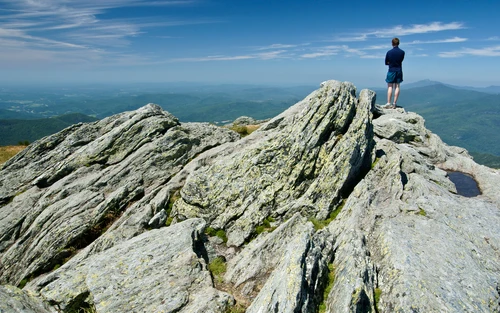Summit of Silence: Hiking Camel's Hump on the Long Trail
A blunt, wind-sculpted summit with alpine views and old-growth stories—what to know before you climb
Photo by Zack C
Shutterstock (ID: 66502288)
You break tree line as the last conifers thin to a wind-bent meadow and suddenly the world opens. Granite ribs lead your eyes to a rounded, solitary hump—Camel’s Hump—rising out of Vermont’s green like a blunt fist. Wind is the narrator here: it pushes, scours, and cleanses. It flattens the grasses, teases the clouds, and carries the smell of maple and mountain cool down the slope. Underfoot the trail rattles with the quick, urgent steps of hikers and the soft clack of microspikes when late-season ice tucks itself into root systems.
Trail Wisdom
Arrive early to beat the crowds
Parking at the Burrows trailhead fills quickly, especially on weekends and during fall foliage—aim for daybreak to secure a spot.
Respect the alpine zone
Stay on trails and rock; summit vegetation is fragile and can take decades to recover from foot traffic.
Bring traction in shoulder seasons
Microspikes or light crampons are essential in early spring or late fall when the trail on the ridge can ice over.
Carry sufficient water and sun protection
There’s no reliable water on the upper trail and the summit is exposed—pack at least 2 liters, sunscreen, and a wind shell.
Local Knowledge
Hidden Gems
- •Hike a short stretch of the Long Trail north or south from the summit for quieter viewpoints
- •Early-morning visits to Monroe Trailhead offer soft light and fewer hikers on the lower slopes
Wildlife
white-tailed deer, varied thrushes and warblers during migration
Conservation Note
The summit’s alpine tundra is extremely fragile; staying on designated paths and boots-clean practices help prevent erosion and protect rare plants.
The Long Trail, completed in the 1930s by the Green Mountain Club, links Camel’s Hump to a statewide corridor of protected ridges and was instrumental in early conservation efforts in Vermont.
Seasonal Guide
spring
Best for: wildflower transition, fewer crowds, cool temperatures
Challenges: muddy trails, variable snow patches, ice on shaded sections
Spring offers quiet trails and emerging flora, but expect mud and lingering snow—traction and gaiters are useful.
summer
Best for: long daylight, warm weather, wildlife viewing
Challenges: black flies and mosquitos, thicker crowds, hotter valley temps
Summer brings warm days and full views—early starts beat bugs and heat, and hydration is key.
fall
Best for: peak foliage, clear air, photography
Challenges: high visitor numbers, variable weather, shorter daylight
Fall rewards with spectacular colors and crisp air; plan for crowds and layer for rapid temperature shifts.
winter
Best for: snow-covered scenery, quiet solitude, snowshoeing and winter skills practice
Challenges: deep snow, ice on ridge, limited daylight and cold
Winter transforms the Hump into a rigorous alpine outing—microspikes, snowshoes, and winter navigation skills are required.
Photographer's Notes
What to Bring
Sturdy hiking bootsEssential
Provide traction and ankle support on rooty and rocky sections.
Wind shell or lightweight insulated jacketEssential
Summit exposure brings wind and rapid temperature drops—pack a warm, windproof layer.
MicrospikesEssential
Essential for late-fall, winter and spring ice on ridgelines and exposed rock.
2L water reservoirEssential
There is no reliable summit water—carry sufficient hydration for the round trip.
Common Questions
How long is the hike to Camel’s Hump summit?
The Burrows Trail is about 4.8 miles round trip with roughly 2,100 feet of elevation gain; allow 3–5 hours depending on pace and conditions.
Is the trail dog-friendly?
Dogs are allowed on the trails but must be under control; be prepared to assist your dog on exposed or rocky sections and to carry out waste.
Do I need a permit or fee to hike Camel’s Hump?
There is no required permit to hike, but some parking areas may have a fee or limited spaces—check Camel’s Hump State Park information before visiting.
Can I camp overnight near Camel’s Hump?
Yes—designated campsites exist within Camel’s Hump State Park and backpackers can use sections of the Long Trail for multi-day trips; follow site regulations and camp only in designated areas.
When is the best time to see fall foliage from the summit?
Mid-to-late October typically provides peak color, though timing varies year to year with elevation and weather—plan a flexible window and expect larger crowds during peak color weeks.
Are there hazards I should know about?
Exposed ridge sections can be windy and icy; sudden weather changes occur frequently—carry layers, navigation tools, and traction for cold months.
What to Pack
Hiking boots (traction & ankle support), 2L water (no summit water), wind shell (exposed summit chills), microspikes (shoulder seasons/winter)
Did You Know
Camel’s Hump is Vermont’s third-highest peak at 4,083 feet and its summit supports an alpine tundra ecosystem—rare in the northeastern U.S.
Quick Travel Tips
Arrive before 8 a.m. for parking; check weather and avalanche/ice advisories in winter; pack out all trash and toilet paper; support local businesses in Huntington or Burlington after your hike.
Local Flavor
Post-hike, reward yourself with a Vermont creamery cone, local maple syrup souvenirs, and a pint at a Waterbury or Stowe brewery—trail culture here skews toward low-key, conservation-minded hospitality.
Logistics Snapshot
Trailhead: Burrows/Route 17; Distance/Elevation: ~4.8 mi RT, ~2,100 ft gain; Difficulty: challenging day-hike; Permits: none, parking may be limited; Dogs: allowed on trails—carry out waste.
Sustainability Note
Stick to durable surfaces in the alpine zone, clean boots before and after hiking to avoid invasive seeds, pack out waste, and favor established campsites to reduce impact.

